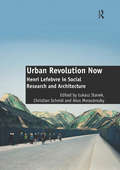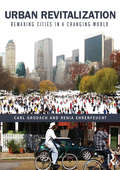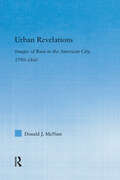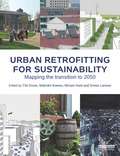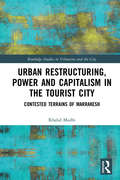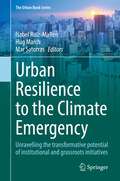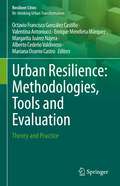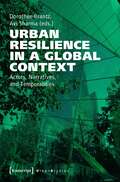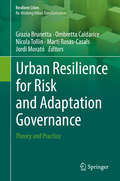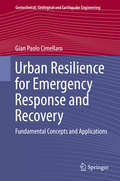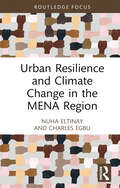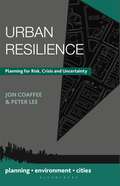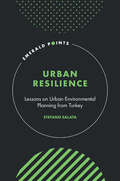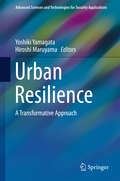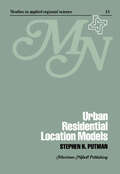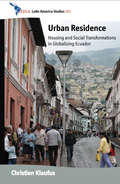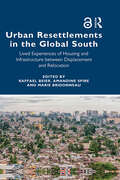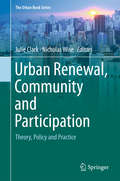- Table View
- List View
Urban Revolution Now: Henri Lefebvre in Social Research and Architecture
by Christian SchmidWhen Henri Lefebvre published The Urban Revolution in 1970, he sketched a research itinerary on the emerging tendency towards planetary urbanization. Today, when this tendency has become reality, Lefebvre’s ideas on everyday life, production of space, rhythmanalysis and the right to the city are indispensable for the understanding of urbanization processes at every scale of social practice. This volume is the first to develop Lefebvre’s concepts in social research and architecture by focusing on urban conjunctures in Barcelona, Belgrade, Berlin, Budapest, Copenhagen, Dhaka, Hong Kong, London, New Orleans, Nowa Huta, Paris, Toronto, São Paulo, Sarajevo, as well as in Mexico and Switzerland. With contributions by historians and theorists of architecture and urbanism, geographers, sociologists, political and cultural scientists, Urban Revolution Now reveals the multiplicity of processes of urbanization and the variety of their patterns and actors around the globe.
Urban Revolution Now: Henri Lefebvre in Social Research and Architecture
by Christian SchmidWhen Henri Lefebvre published The Urban Revolution in 1970, he sketched a research itinerary on the emerging tendency towards planetary urbanization. Today, when this tendency has become reality, Lefebvre’s ideas on everyday life, production of space, rhythmanalysis and the right to the city are indispensable for the understanding of urbanization processes at every scale of social practice. This volume is the first to develop Lefebvre’s concepts in social research and architecture by focusing on urban conjunctures in Barcelona, Belgrade, Berlin, Budapest, Copenhagen, Dhaka, Hong Kong, London, New Orleans, Nowa Huta, Paris, Toronto, São Paulo, Sarajevo, as well as in Mexico and Switzerland. With contributions by historians and theorists of architecture and urbanism, geographers, sociologists, political and cultural scientists, Urban Revolution Now reveals the multiplicity of processes of urbanization and the variety of their patterns and actors around the globe.
Urban Revitalization: Remaking cities in a changing world
by Carl Grodach Renia EhrenfeuchtFollowing decades of neglect and decline, many US cities have undergone a dramatic renaissance. From New York to Nashville and Pittsburgh to Portland governments have implemented innovative redevelopment strategies to adapt to a globally integrated, post-industrial economy and cope with declining industries, tax bases, and populations. However, despite the prominence of new amenities in revitalized neighborhoods, spectacular architectural icons, and pedestrian friendly entertainment districts, the urban comeback has been highly uneven. Even thriving cities are defined by a bifurcated population of creative class professionals and a low-wage, low-skilled workforce. Many are home to diverse and thriving immigrant communities, but also contain economically and socially segregated neighborhoods. They have transformed high-profile central city brownfields, but many disadvantaged neighborhoods continue to grapple with abandoned and environmentally contaminated sites. As urban cores boom, inner-ring suburban areas increasingly face mounting problems, while other shrinking cities continue to wrestle with long-term decline. The Great Recession brought additional challenges to planning and development professionals and community organizations alike as they work to maintain successes and respond to new problems. It is crucial that students of urban revitalization recognize these challenges, their impacts on different populations, and the implications for crafting effective and equitable revitalization policy. Urban Revitalization: Remaking Cities in a Changing World will be a guide in this learning process. This textbook will be the first to comprehensively and critically synthesize the successful approaches and pressing challenges involved in urban revitalization. The book is divided into five sections. In the introductory section, we set the stage by providing a conceptual framework to understand urban revitalization that links a political economy perspective with an appreciation of socio-cultural factors in explaining urban change. Stemming from this, we will explain the significance of revitalization and present a summary of the key debates, issues and conflicts surrounding revitalization efforts. Section II will examine the historical causes for decline in central city and inner-ring suburban areas and shrinking cities and, building from the conceptual framework, discuss theory useful to explain the factors that shape contemporary revitalization initiatives and outcomes. Section III will introduce students to the analytical techniques and key data sources for urban revitalization planning. Section IV will provide an in-depth, criticaldiscussion of contemporary urban revitalization policies, strategies, and projects. This section will offer a rich set of case studies that contextualize key themes and strategic areas across a range of contexts including the urban core, central city neighborhoods, suburban areas, and shrinking cities. Lastly, Section V concludes by reflecting on the current state of urban revitalization planning and the emerging challenges the field must face in the future.Urban Revitalization will integrate academic and policy research with professional knowledge and techniques. Its key strength will be the combination of a critical examination of best practices and innovative approaches with an overview of the methods used to understand local situations and urban revitalization processes. A unique feature will be chapter-specific case studies of contemporary urban revitalization projects and questions geared toward generatingclassroom discussion around key issues. The book will be written in an accessible style and thoughtfully organized to provide graduate and upper-level undergraduate students with a comprehensive resource that will also serve as a reference guide for professionals
Urban Revitalization: Remaking cities in a changing world
by Carl Grodach Renia EhrenfeuchtFollowing decades of neglect and decline, many US cities have undergone a dramatic renaissance. From New York to Nashville and Pittsburgh to Portland governments have implemented innovative redevelopment strategies to adapt to a globally integrated, post-industrial economy and cope with declining industries, tax bases, and populations. However, despite the prominence of new amenities in revitalized neighborhoods, spectacular architectural icons, and pedestrian friendly entertainment districts, the urban comeback has been highly uneven. Even thriving cities are defined by a bifurcated population of creative class professionals and a low-wage, low-skilled workforce. Many are home to diverse and thriving immigrant communities, but also contain economically and socially segregated neighborhoods. They have transformed high-profile central city brownfields, but many disadvantaged neighborhoods continue to grapple with abandoned and environmentally contaminated sites. As urban cores boom, inner-ring suburban areas increasingly face mounting problems, while other shrinking cities continue to wrestle with long-term decline. The Great Recession brought additional challenges to planning and development professionals and community organizations alike as they work to maintain successes and respond to new problems. It is crucial that students of urban revitalization recognize these challenges, their impacts on different populations, and the implications for crafting effective and equitable revitalization policy. Urban Revitalization: Remaking Cities in a Changing World will be a guide in this learning process. This textbook will be the first to comprehensively and critically synthesize the successful approaches and pressing challenges involved in urban revitalization. The book is divided into five sections. In the introductory section, we set the stage by providing a conceptual framework to understand urban revitalization that links a political economy perspective with an appreciation of socio-cultural factors in explaining urban change. Stemming from this, we will explain the significance of revitalization and present a summary of the key debates, issues and conflicts surrounding revitalization efforts. Section II will examine the historical causes for decline in central city and inner-ring suburban areas and shrinking cities and, building from the conceptual framework, discuss theory useful to explain the factors that shape contemporary revitalization initiatives and outcomes. Section III will introduce students to the analytical techniques and key data sources for urban revitalization planning. Section IV will provide an in-depth, criticaldiscussion of contemporary urban revitalization policies, strategies, and projects. This section will offer a rich set of case studies that contextualize key themes and strategic areas across a range of contexts including the urban core, central city neighborhoods, suburban areas, and shrinking cities. Lastly, Section V concludes by reflecting on the current state of urban revitalization planning and the emerging challenges the field must face in the future.Urban Revitalization will integrate academic and policy research with professional knowledge and techniques. Its key strength will be the combination of a critical examination of best practices and innovative approaches with an overview of the methods used to understand local situations and urban revitalization processes. A unique feature will be chapter-specific case studies of contemporary urban revitalization projects and questions geared toward generatingclassroom discussion around key issues. The book will be written in an accessible style and thoughtfully organized to provide graduate and upper-level undergraduate students with a comprehensive resource that will also serve as a reference guide for professionals
Urban Revelations: Cities, Homes, and Other Ruins in American Literature, 1790-1860
by Donald J. McNuttThis study reexamines the ethos of national progress by analyzing how American writers import images of ruins from European aesthetics to cast the city as a site of instability and cultural impermanence. While highlighting the transatlantic currency of ruin imagery, the study demonstrates through interdisciplinary analyses of architecture and material culture how American images of ruin intersect with the symbolic geographies of city and home to shape and reflect citizenship, law, and perceptions of race. Arguing that ruin imagery works to disclose the culture's inner dimensions, the study incorporates deep archival research and synthesizes theories on geography and architecture to read unstable settings in the works of Philip Freneau, Charles Brockden Brown, Poe, and Melville. The study focuses on the ways these writers relied on ruin imagery to interpret such subjects as Anglo-Indian relations in the nation's early capital; the dialogue between secrecy and yellow fever in 1790s Philadelphia; the impact of antebellum penitentiaries on conceptions of mind and domestic space; and the mutability of nationhood in the decade just before the Civil War. The book provides dynamic ways of reading the relationships among urban culture, ruin, concepts of instability, and the formation of American literature.
Urban Retrofitting for Sustainability: Mapping the Transition to 2050
by Tim Dixon Malcolm Eames Miriam Hunt Simon LannonWith a foreword from Paul King, Chief Executive, UK Green Building Council and Chairman, Zero Carbon Hub As concerns over climate change and resource constraints grow, many cities across the world are trying to achieve a low carbon transition. Although new zero carbon buildings are an important part of the story, in existing cities the transformation of the current building stock and urban infrastructure must inevitably form the main focus for transitioning to a low carbon and sustainable future by 2050. Urban Retrofitting for Sustainability brings together interdisciplinary research contributions from leading international experts to focus on key issues such as systems innovation, financing tools, governance, energy, and water management. The chapters consider not only the knowledge and technical tools available, but looks forward to how they can be implemented in real cities by 2050.
Urban Retrofitting for Sustainability: Mapping the Transition to 2050
by Tim Dixon Malcolm Eames Miriam Hunt Simon LannonWith a foreword from Paul King, Chief Executive, UK Green Building Council and Chairman, Zero Carbon Hub As concerns over climate change and resource constraints grow, many cities across the world are trying to achieve a low carbon transition. Although new zero carbon buildings are an important part of the story, in existing cities the transformation of the current building stock and urban infrastructure must inevitably form the main focus for transitioning to a low carbon and sustainable future by 2050. Urban Retrofitting for Sustainability brings together interdisciplinary research contributions from leading international experts to focus on key issues such as systems innovation, financing tools, governance, energy, and water management. The chapters consider not only the knowledge and technical tools available, but looks forward to how they can be implemented in real cities by 2050.
Urban Restructuring, Power and Capitalism in the Tourist City: Contested Terrains of Marrakesh (Routledge Studies in Urbanism and the City)
by Khalid MadhiThe book focuses on the processes of urban restructuring, power relations and the political economy of touristic authenticity. Through an in-depth analysis of Marrakesh, Morroco, the book proposes a comprehensive analytic framework. It highlights the issues of (post)coloniality, ideology, heritage-commodification, subjectivity and counter-conduct in the shadow of global capitalism. It explores how power relations and political ecomomy have shaped the city of Marrakesh over the past few decades, formulating new subjectivities. It reveals how urban policy’s sole purpose is to boost tourism in the city, bringing into question the long-term resilience and success of tourism as an economic activity and a policy choice. This book considers how the well-being of city residents is submitted to such policies, conforming to certain forms of appropriation – of land, culture and memory. The example of Morocco helps us understand a phenomenon affecting many other cities internationally. This book will be valuable to academics and practitioners across disciplines, including geography, political science, urban planning and architecture.
Urban Restructuring, Power and Capitalism in the Tourist City: Contested Terrains of Marrakesh (Routledge Studies in Urbanism and the City)
by Khalid MadhiThe book focuses on the processes of urban restructuring, power relations and the political economy of touristic authenticity. Through an in-depth analysis of Marrakesh, Morroco, the book proposes a comprehensive analytic framework. It highlights the issues of (post)coloniality, ideology, heritage-commodification, subjectivity and counter-conduct in the shadow of global capitalism. It explores how power relations and political ecomomy have shaped the city of Marrakesh over the past few decades, formulating new subjectivities. It reveals how urban policy’s sole purpose is to boost tourism in the city, bringing into question the long-term resilience and success of tourism as an economic activity and a policy choice. This book considers how the well-being of city residents is submitted to such policies, conforming to certain forms of appropriation – of land, culture and memory. The example of Morocco helps us understand a phenomenon affecting many other cities internationally. This book will be valuable to academics and practitioners across disciplines, including geography, political science, urban planning and architecture.
Urban Resilience to the Climate Emergency: Unravelling the transformative potential of institutional and grassroots initiatives (The Urban Book Series)
by Isabel Ruiz-Mallén Hug March Mar SatorrasThis volume sheds light on urban resilience strategies in times of climate emergency and social and economic crisis by reflecting on related social vulnerabilities and inequalities within cities and showing the potential of participatory governance approaches for socio-environmental transformation. The book compiles critical research documenting the articulation of urban resilience strategies dealing with climatic changes, as well as the understanding of the unexpected implications of top-down resilience plans to address the impacts of climate change in cities, especially on the most vulnerable urban populations, and the transformative capacities of bottom-up and socially innovative resilience strategies. The book especially focuses on co-produced and grassroots transformative processes that are concerned with social equity in urban planning for climate change. Although several publications cover the topic of urban resilience, this book provides a more nuanced exploration of urban climate governance and citizen engagement in urban climate resilience policies through the lenses of political ecology, environmental justice and co-production. In this regard, the volume moves beyond the approach of multilevel urban climate governance by critically addressing the unexpected impacts of top-down strategies of urban resilience with the goal of expanding the reflection on citizen engagement. The book also explores the emerging possibilities behind the co-production of urban resilience as well as the critical role of grassroots and citizens in promoting such alternative strategies. While the primary target audience is scholars from different disciplines (e.g. geography, urban studies, planning, political ecology, architecture, urban sociology, environmental studies) focusing on urban resilience, the editors also aim to reach urban resilience practitioners from local, national and international organisations as well as environmental grassroots and climate activists.
Urban Resilience: Theory and Practice (Resilient Cities)
by Octavio Francisco González Castillo Valentina Antoniucci Enrique Mendieta Márquez Margarita Juárez Nájera Alberto Cedeño Valdiviezo Mariana Osorno CastroThis book presents a select set of papers from an international and multidisciplinary approach, outlining the vanguard in the field of methodology, tools, and evaluation of the movement towards urban resilience.Reflecting on and redesigning the guidelines that orient the planning and management of urban development has become, today, an issue of global scope and priority that demands the committed and determined participation of society. Faced with the formidable challenge of guiding our cities towards sustainability, it is necessary to develop new approaches, paradigms, models, methodologies, and tools that make it possible to assess and raise the resilience profile of urban socio-ecosystems. The experiences that are developed in this book offer a wide and diverse set of concepts, theories, methodologies, instruments, and casuistry, impregnated by resilience notion, to inspire, influence, and guide thinking and practice for architects, urban planners, government officials, businessmen, civil and research organizations. In this book, the reader will be able to review either theoretical-methodology to organize notions on urban resilience, or application cases in a variety of areas and subsystems of a city but, being all of them inevitably and intricately linked through a complex matrix of structures and interactions that determine future, well-being, and resilience of urban socio-ecosystems in the global anthropo-environment.
Urban Resilience in a Global Context: Actors, Narratives, and Temporalities (Urban Studies)
by Dorothee Brantz Avi SharmaUrban Resilience is seen by many as a tool to mitigate harm in times of extreme social, political, financial, and environmental stress. Despite its widespread usage, however, resilience is used in different ways by policy makers, activists, academics, and practitioners. Some see it as a key to unlocking a more stable and secure urban future in times of extreme global insecurity; for others, it is a neoliberal technology that marginalizes the voices of already marginal peoples. This volume moves beyond praise and critique by focusing on the actors, narratives and temporalities that define urban resilience in a global context. By exploring the past, present, and future of urban resilience, this volume unlocks the potential of this concept to build more sustainable, inclusive, and secure cities in the 21st century.
Urban Resilience for Risk and Adaptation Governance: Theory and Practice (Resilient Cities)
by Grazia Brunetta Ombretta Caldarice Nicola Tollin Marti Rosas-Casals Jordi MoratóThis book brings together a series of theory and practice essays on risk management and adaptation in urban contexts within a resilient and multidimensional perspective. The book proposes a transversal approach with regard to the role of spatial planning in promoting and fostering risk management as well as institutions’ challenges for governing risk, particularly in relation to new forms of multi-level governance that may include stakeholders and citizen engagement. The different contributions focus on approaches, policies, and practices able to contrast risks in urban systems generating social inclusion, equity and participation through bottom-up governance forms and co-evolution principles. Case studies focus on lessons learned, as well as the potential and means for their replication and upscaling, also through capacity building and knowledge transfer. Among many other topics, the book explores difficulties encountered in, and creative solutions found, community and local experiences and capacities, organizational processes and integrative institutional, technical approaches to risk issue in cities.
Urban Resilience for Emergency Response and Recovery: Fundamental Concepts and Applications (Geotechnical, Geological and Earthquake Engineering #41)
by Gian Paolo CimellaroThis book introduces the concepts of Resilience-Based Design (RBD) as an extension of Performance-Based Design. It provides readers with a range of cutting-edge methodologies for evaluating resilience and clarifies the difference between resilience, vulnerability and sustainability. Initially, the book focuses on describing the different types of uncertainty that arise in the context of resilience evaluation. This is followed by an entire chapter dedicated to the analytical and experimental recovery functions. Then, starting from the definition of resilience provided by MCEER, an extension of the methodology is provided that introduces the seven dimensions of Community Resilience, summarized in the acronym PEOPLES. They are: Population and Demographics, Environmental/Ecosystem, Organized Governmental Services, Physical infrastructures, Lifestyle and Community Competence, Economic Development, and Socio-Cultural Capital. For each dimension, components and subcomponents are defined and the related indices are provided.Underlining the importance of the physical infrastructure dimension, the book provides several examples of applications for transportation, hydraulic, gas and power networks. The problem of interdependencies and the domino effect is also taken into account during the analysis. One of the book’s closing chapters focuses on different methodologies for improving disaster preparedness and engineering mitigation strategies, while the last chapter describes the different computer platforms available on the market for evaluating Community Resilience.The book offers readers an extensive introduction to the concept of Resilience-Based Design, together with selected advanced applications for specialists. No prerequisite knowledge is needed in order to understand the book, and the Appendix offers valuable supplemental information on e.g. the probabilistic concepts. As such, the book offers a valuable resource for graduate students, young engineers and researchers who are interested in the topic, and can also be used as a supplementary text in graduate level Disaster Resilience courses.
Urban Resilience and Climate Change in the MENA Region (Routledge Focus on Environment and Sustainability)
by Nuha Eltinay Charles EgbuThis book provides an overview of the geopolitical context and climate change risk profile of the Middle East and North Africa (MENA) Region. Mapping existing scientific literature and key reports on MENA climate change impacts and future projections, Nuha Eltinay and Charles Egbu establish links between the Conference of the Parties (from COP26, COP27 to COP28) Glasgow–Sharm el-Sheikh Work Program for Progress on the Global Goal on Adaptation, and regional climate adaptation financing targets, national government investments, and human security in local case studies. They also address gaps in disaster risk reduction institutional governance for sustainable development in the region. The authors move beyond the existing theoretical understanding of urban resilience to investigate how it is being measured and assessed in MENA in alignment with the IPCC’s climate change adaptation indicators. Finally, they explore how disasters and conflict displacement vulnerabilities and fragility affecting the communities most in need are being measured and integrated into cities’ resilience action plans and national disaster risk policies. Providing guidance and policy recommendations based on empirical research and key stakeholder engagement observations, this book will be of great interest to students, scholars, and professionals who are researching and working in the areas of climate change, urban planning, and environmental policy and governance. As this book comes out just after the closure of The United Nations Climate Change Conference COP28 negotiations, it sets the scene for pre-COP regional context, and paves the way for researchers and practitioners to undertake post-COP28 key takeaways and multi-level government commitments into action, for better climate mitigation and adaptation investments, resilient and sustainable future for all.
Urban Resilience and Climate Change in the MENA Region (Routledge Focus on Environment and Sustainability)
by Nuha Eltinay Charles EgbuThis book provides an overview of the geopolitical context and climate change risk profile of the Middle East and North Africa (MENA) Region. Mapping existing scientific literature and key reports on MENA climate change impacts and future projections, Nuha Eltinay and Charles Egbu establish links between the Conference of the Parties (from COP26, COP27 to COP28) Glasgow–Sharm el-Sheikh Work Program for Progress on the Global Goal on Adaptation, and regional climate adaptation financing targets, national government investments, and human security in local case studies. They also address gaps in disaster risk reduction institutional governance for sustainable development in the region. The authors move beyond the existing theoretical understanding of urban resilience to investigate how it is being measured and assessed in MENA in alignment with the IPCC’s climate change adaptation indicators. Finally, they explore how disasters and conflict displacement vulnerabilities and fragility affecting the communities most in need are being measured and integrated into cities’ resilience action plans and national disaster risk policies. Providing guidance and policy recommendations based on empirical research and key stakeholder engagement observations, this book will be of great interest to students, scholars, and professionals who are researching and working in the areas of climate change, urban planning, and environmental policy and governance. As this book comes out just after the closure of The United Nations Climate Change Conference COP28 negotiations, it sets the scene for pre-COP regional context, and paves the way for researchers and practitioners to undertake post-COP28 key takeaways and multi-level government commitments into action, for better climate mitigation and adaptation investments, resilient and sustainable future for all.
Urban Resilience (Planning, Environment, Cities)
by Peter Lee Jon CoaffeeAs the cities of the world increasingly come under threat from crisis and disaster, planners are searching for ways to build resilience into the foundations of modern urban centres.This important book provides a comprehensive account of the theory and practice of urban resilience in response to a range of disruptions, including terrorism, climate change and economic crises. It examines how the concepts and principles of resilience exert increasing significant influence over the form and function of planning. Discussing a 'politics of resilience' in which fundamental questions of social and spatial justice are posed, this book examines how urban planners are increasingly tasked with the responsibility of safeguarding the future of urbanised centres and those that live in them. Drawing on international examples and detailed case-studies, this book provides a nuanced account of the uses, and misuses, of resilience and points a way forward for planning activity, from an approach that is too often narrowly technical in focus towards an integrated and adaptable model for coping with risk, crisis and uncertainty. It will make essential reading for students of urban planning and researchers alike.
Urban Resilience: Lessons on Urban Environmental Planning from Turkey (Emerald Points)
by Stefano SalataAdvocating for the reintroduction of natural areas and biodiverse green spaces within our cities, Urban Resilience stems from the two years’ experience living and teaching ecological planning in Turkey. What is resilience? What does it mean practically to design resilient cities? Demonstrating that the expansion of the ecological footprint of urban areas is no longer sustainable, Stefano Salata underscores that authentic resilience in urban planning necessitates embracing the reduction and de-sealing of urban surfaces, which he advocates for as the sole viable means of confronting the challenges posed by climate change. Providing a fresh methodological outlook on urban adaptation, Salata introduces a novel approach to understanding resilience, streamlining the key components of knowledge that urban planners need to acquire in order to effectively address the challenges posed by climate change. Supplemented with short personal reflections on Turkish space and society, this study explores the societal significance of embracing a new cultural paradigm characterized by reduced consumerism. Taking the Turkish case as a pioneering testing ground, Salata substantiates the potential of resilient approaches for urban transformation, affording us the opportunity to evaluate the efficacy of various solutions across the globe.
Urban Resilience: Lessons on Urban Environmental Planning from Turkey (Emerald Points)
by Stefano SalataAdvocating for the reintroduction of natural areas and biodiverse green spaces within our cities, Urban Resilience stems from the two years’ experience living and teaching ecological planning in Turkey. What is resilience? What does it mean practically to design resilient cities? Demonstrating that the expansion of the ecological footprint of urban areas is no longer sustainable, Stefano Salata underscores that authentic resilience in urban planning necessitates embracing the reduction and de-sealing of urban surfaces, which he advocates for as the sole viable means of confronting the challenges posed by climate change. Providing a fresh methodological outlook on urban adaptation, Salata introduces a novel approach to understanding resilience, streamlining the key components of knowledge that urban planners need to acquire in order to effectively address the challenges posed by climate change. Supplemented with short personal reflections on Turkish space and society, this study explores the societal significance of embracing a new cultural paradigm characterized by reduced consumerism. Taking the Turkish case as a pioneering testing ground, Salata substantiates the potential of resilient approaches for urban transformation, affording us the opportunity to evaluate the efficacy of various solutions across the globe.
Urban Resilience: A Transformative Approach (Advanced Sciences and Technologies for Security Applications #65)
by Yoshiki Yamagata Hiroshi MaruyamaThis book is on urban resilience – how to design and operate cities that can withstand major threats such as natural disasters and economic downturns and how to recover from them. It is a collection of latest research results from two separate but collaborating research groups, namely, researchers in urban design and those on general resilience theory. The book systematically deals with the core aspects of urban resilience: systems, management issues and populations.The taxonomy can be broken down into threats, systems, resilience cycles and recovery types in the context of urban resilience. It starts with a discussion of systems resilience models, focusing on the central idea that resilience is a moving average of costs (a set of trajectories in a two-player game paradigm). The second section explores management issues, including planning, operating and emergency response in cities with specific examples such as land-use planning and carbon-neutral scenarios for urban planning. The next section focuses on urban dwellers and specific people-related issues in the context of resilience. Agent-based simulation of behaviour and perception-based resilience, as well as brand crisis management are representative examples of the topics discussed. A further section examines systems like public utilities – including managing power supplies, cyber-security issues and models for pandemics. It concludes with a discussion of the future challenges and risks facing complex systems, for example in resilient power grids, making it essential reading for a wide range of researchers and policymakers.
Urban residential location models (Studies in Applied Regional Science #13)
by S.H. PutmanThe decade of the 1970's has seen substantial improvement in our under standing of the determinants of urban spatial patterns. It is typical of western science and technology of the past several centuries that these advances in urban spatial analysis have resulted from the efforts of many individuals. No one of these claims to have found the answer; rather, each contributes some additional understanding of a rather complex set of inter related phenomena. All of this most recent work, in one way or another, rests on preliminary analysis work done in the previous ten to fifteen years. Those earlier efforts are the subject of this book. A very few studies of urban spatial patterns were done prior to 1960. However, it was not until then, with the coming of age of electronic data processing machinery, that work began in earnest. Many theories and theoretical models of urban form were postulated, and some were tested. Often the tests were inconclusive or unsuccessful. The theories often lacked consistency and coherence. Some of the testing was inadequate or even inappropriate. Much of the research was done amidst the turmoil (and sometimes chaos) of attempted (and often premature) application. The results were frequently incompletely described, if described at all. Yet, out of all this, there began to emerge some clearer notion of the determinants of urban spatial patterns.
Urban Residence: Housing and Social Transformations in Globalizing Ecuador (CEDLA Latin America Studies #100)
by Christien KlaufusRiobamba and Cuenca, two intermediate cities in Ecuador, have become part of global networks through transnational migration, incoming remittances, tourism, and global economic connections. Their landscape is changing in several significant ways, a reflection of the social and urban transformations occurring in contemporary Ecuadorian society. Exploring the discourses and actions of two contrasting population groups, rarely studied in tandem, within these cities—popular-settlement residents and professionals in the planning and construction sector—this study analyzes how each is involved in house designs and neighborhood consolidation. Ideas, ambitions, and power relations come into play at every stage of the production and use of urban space, and as a result individual decisions about both house designs and the urban layout influence the development of the urban fabric. Knowledge about intermediate cities is crucial in order to understand current trends in the predominantly urban societies of Latin America, and this study is an example of needed interdisciplinary scholarship that contributes to the fields of urban studies, urban anthropology, sociology, and architecture.
Urban Resettlements in the Global South: Lived Experiences of Housing and Infrastructure between Displacement and Relocation
by Raffael BeierUrban Resettlements in the Global South provides new perspectives on resettlement through an urban studies lens. To date, resettlement has been theorised through development studies and refugee studies, but urban resettlement is also a major dimension of urban development in the Global South and may help to rethink contemporary urban dynamics between spectacular new town developments and rising incidences of eviction and displacement. Conceptualising resettlement as a binding notion between production/regeneration and destruction/demolition of urban space helps to illuminate interdependencies and to underline significant ambiguities within affected people’s perspectives towards resettlement projects. This volume will offer an interesting selection of ten different case studies with rich empirical data from Latin America, North and Sub-Saharan Africa, and Asia, focused on each stage of resettlement (before, during, after relocation) through different timescales. By offering a frame for analysing and rethinking resettlement within urban studies, it will support any scholar or expert dealing with resettlement, displacement, and housing in an urban context, seeking to improve housing and planning policies in and for the city.
Urban Resettlements in the Global South: Lived Experiences of Housing and Infrastructure between Displacement and Relocation
by Raffael Beier Amandine Spire Marie BridonneauUrban Resettlements in the Global South provides new perspectives on resettlement through an urban studies lens. To date, resettlement has been theorised through development studies and refugee studies, but urban resettlement is also a major dimension of urban development in the Global South and may help to rethink contemporary urban dynamics between spectacular new town developments and rising incidences of eviction and displacement. Conceptualising resettlement as a binding notion between production/regeneration and destruction/demolition of urban space helps to illuminate interdependencies and to underline significant ambiguities within affected people’s perspectives towards resettlement projects. This volume will offer an interesting selection of ten different case studies with rich empirical data from Latin America, North and Sub-Saharan Africa, and Asia, focused on each stage of resettlement (before, during, after relocation) through different timescales. By offering a frame for analysing and rethinking resettlement within urban studies, it will support any scholar or expert dealing with resettlement, displacement, and housing in an urban context, seeking to improve housing and planning policies in and for the city.
Urban Renewal, Community and Participation: Theory, Policy and Practice (The Urban Book Series)
by Julie Clark Nicholas WiseThis edited collection investigates the human dimension of urban renewal, using a range of case studies from Africa, Asia, Europe, India and North America, to explore how the conception and delivery of regeneration initiatives can strengthen or undermine local communities. Ultimately aiming to understand how urban residents can successfully influence or manage change in their own communities, contributing authors interrogate the complex relationships between policy, planning, economic development, governance systems, history and urban morphology. Alongside more conventional methods, analytical approaches include built form analysis, participant observation, photographic analysis and urban labs. Appealing to upper level undergraduate and masters' students, academics and others involved in urban renewal, the book offers a rich combination of theoretical insight and empirical analysis, contributing to literature on gentrification, the right to the city, and community participation in neighbourhood change.
